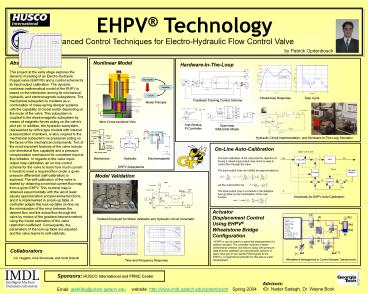Advanced Control Techniques for ElectroHydraulic Flow Control Valve - PowerPoint PPT Presentation
1 / 1
Title:
Advanced Control Techniques for ElectroHydraulic Flow Control Valve
Description:
... modeling of an Electro-Hydraulic Poppet valve (EHPV ) and a control scheme ... The dynamic nonlinear mathematical model of the EHPV is based on the interaction ... – PowerPoint PPT presentation
Number of Views:279
Avg rating:3.0/5.0
Title: Advanced Control Techniques for ElectroHydraulic Flow Control Valve
1
EHPV Technology
Advanced Control Techniques for Electro-Hydraulic
Flow Control Valve
by Patrick Opdenbosch
Abstract This project at the early stage
explores the dynamic modeling of an
Electro-Hydraulic Poppet valve (EHPV) and a
control scheme for its input-output calibration.
The dynamic nonlinear mathematical model of the
EHPV is based on the interaction among its
mechanical, hydraulic, and electromagnetic
subsystems. The mechanical subsystem is modeled
as a combination of mass-spring-damper systems
with the capability of model switch depending on
the mode of the valve. This subsystem is coupled
to the electromagnetic subsystem by means of
magnetic forces acting on the valves pilot pin.
In addition, the hydraulic subsystem, represented
by orifice type models with internal
pressurization chambers, is also coupled to the
mechanical subsystem via pressures acting on the
faces of the mechanical components. Two of the
most important features of the valve include a
bi-directional flow capability and a pressure
compensation mechanism for consistent input at
flow initiation. In regards to the valve
input-output map calibration, an on-line control
scheme for the valve to learn how much current it
needs to meet a required flow under a given
pressure differential (self-calibration) is
explored. The self-calibration of the valve is
started by obtaining a nominal current-flow map
from a given EHPV. This nominal map is obtained
experimentally with the aid of least square
approximation and piecewise functions, and it is
implemented in a look-up table. A controller
adapts this look-up table on-line via the
minimization of the error between the desired
flow and the actual flow through the valve by
means of the gradient descent method using the
model estimation of the valve restriction
coefficient. Consequently, the parameters of the
look-up table are adjusted and the valve learns
to self-calibrate.
Nonlinear Model
Hardware-In-The-Loop
Closed-loop Response
Duty Cycle
Feedback Tracking Control Scheme
Model Principle
Valve Cross-sectional View
Anti-Windup PI Controller
Open-loop SIMULINK Model
Hydraulic Circuit Implementation and
Hardware-In-The-Loop Simulator
On-Line Auto-Calibration
Electromagnetic
Mechanical
Hydraulic
The auto-calibration of the valve has the
objective of having a robust input-output map
which is used to control flow through the valve.
EHPV Subsystems
The input-output map can initially be
approximated by
Model Validation
Let the cost function be
The input-output map is corrected in the adaptive
look-up table by the minimization of the cost
function
Schematic for EHPV Auto-Calibration
Actuator Displacement Control Using EHPV
Wheatstone Bridge Configuration
Testbed Employed for Model Validation and
Hydraulic Circuit Schematic
4 EHPVs can be used to control the displacement
of a passive actuator. The controller receives a
desire performance criterion (not shown) along
with pressure data from the upstream and
downstream portions of each valve and in turn
sends PWM signals to the EHPVs. A hierarchical
controller for this task is under development.
Collaborators
J.D. Huggins, Amir Shenouda, and Scott Driscoll
Time and Frequency Response
Sponsors HUSCO International and FPMC Center
- Advisors
- Dr. Nader Sadegh, Dr. Wayne Book
website http//www.imdl.gatech.edu/opdenbosch
Spring 2004
Email gte608g_at_prism.gatech.edu































